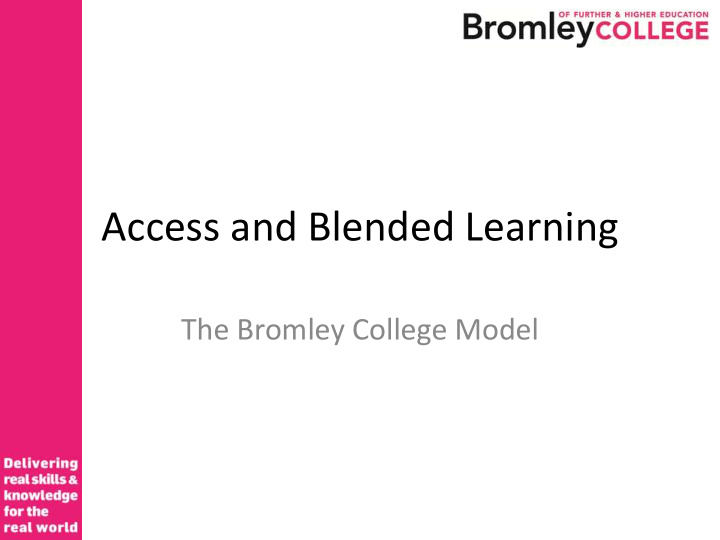



Access and Blended Learning The Bromley College Model
Overview • Why consider a blended learning option? • How blended learning can be implemented
Background • Bromley College has successfully run Access programmes across multiple pathways since the 1980s • Success Rates exceed National Averages… • However, the market place is changing…
Challenges • The introduction of increased tuition fee loans for H.E. (£9,000 + maintenance per year) • The introduction of 24+ loans in F.E. (Access charging in excess of £3,000 for many traditional Access to H.E. programmes) • The issue is not simply fiscal but also one of perception
Headlines in 2012 • Total UCAS Admissions for 2012 down by 7.4% • South East Applications down by 10.2% • London down by 9.8% • Age 23 down by 13.5% • 25-29 down by 11.8% • 30-39 down by 9.9% • 40+ down by 10.2% • By locality and by age Access student applications are above the national average reduction but we must recognize the possible impact of 24+ loans.
The Benefits Issue • The nature of full-time Access provision often impacts upon students who are in receipt of benefit (e.g. Job Seekers) • Students who are in full-time work or are full time carers are disadvantaged by conventional Access programmes (inclusivity issue)
Why Blended then? • To provide a flexible and cost-effective course which provides students the opportunity for entry to university… • To reach markets and individuals that Access had hitherto not been viable for… • To extend the geographic reach of the course offer…
Why Not? • Not to provide ‘bargain basement teaching’ of a ‘bargain basement programme…’ • The motivation must be one of increasing flexibility in response to market demands, whilst upholding excellence in terms of academic rigor!!!
How? • The Open University Model • Massive Open On-Line Courses MOOCs • Khan Academy (use of You Tube in particular) • Bromley College’s own experience in Distance Learning Delivery on the P.G.C.E. programme • There are lessons to be learned from all the above…
Technology • Tentative recognition of the need to provide a bullet proof (and simple) technological model… • Technology could include: • Audio-Lectures associated to power-point • VLE • E-mail • Forums • Phone communication
Towards an Access Model • Using traditional units as a template… and 216 GLH… • VLE provides Hand-outs, audio-lectures and links related to formative assignments (backed up by e-mail and phone support) • 3 week contact sessions on Saturdays. Alternately taught sessions on assessments and study tutorials to provide 1 to 1 feedback on student work (submitted by e-mail) • All formative work feeding into summative assessment
Pros and Cons • A rigorous E-diagnostic and interview to determine correct candidates was set up… This model will not suit all students! • However, whilst we began with a group of highly capable students, the lack of actual tutor contact has not suited all students. Ability in an E-diagnostic does not necessarily identify those comfortable in terms of significant ‘independent learning’. Interviews reflected the need for independent learners but student’s perception of distance learning methods has not always been accurate in terms of the reality of learning in this medium. • Action: Increase group contacts whilst maintaining flexibility
Pros and Cons • Technology was deliberately kept at its simplest. However, most students have encountered few problems… (e.g. voice file activation in power-point) • Therefore, we might be braver in widening the use of technology in future programmes. This could be seen in the adoption of more interactive VLE technology… Quizzes etc.
The future… • Certainly not a replacement for conventional programmes (and should certainly not be seen as such) • Rather an evolution to meet the requirements of a small but growing group of students with a ccess issues… A recognition of ‘widening participation’.
Accessing the Future! • The recognition of parity with A. Level, ABB, signals Access Courses being increasingly accepted as mode of entry to university that is here to stay, but also one that is valued by H.E. as another way to get to university! • However, we must recognize and adapt to changes in our students’ social and economic circumstances if we are to meet the needs of those whom our courses serve
Conclusion • Yes… ‘Knowledge is power ’ (Francis Bacon) • but also… • ‘Knowledge is power. Information is liberating. Education is the premise of progress, in every society, in every family’ (Kofi Annan). • As those with the ‘noble’ function of educating we must do our utmost to respond to the needs of citizens by providing flexible education to empower those whom we serve. • Surely this is the credo of Access!
Recommend
More recommend